hp-ux鎖定用戶密碼
這是什么? (What is this?)
This session is part of a learning curriculum that I designed to incrementally skill up and empower a team of Designers and Researchers whose skillset and ways of working needed to evolve to keep up with changes in the way we think about and execute design.
本課程是學習課程的一部分,我設計該課程的目的是逐步提高技能,并增強一個設計師和研究人員團隊,他們的技能和工作方式需要不斷發展,以適應我們思考和執行設計方式的變化。
Each session in the curriculum aims to simplify the complexities of human-centered interaction design using real-life examples from my own professional experience alongside established theory from industry experts.
課程中的每個課程都旨在利用我自己的專業經驗中的真實示例以及行業專家的既定理論,簡化以人為本的交互設計的復雜性。
The sessions are intentionally structured as short, achievable hands-on learning workshops that balance technique (hands-on, doing) with theory (readout, presentation).
這些會議有意地組織成簡短的,可實現的動手學習研討會,使技術(動手,做事)與理論(讀出,演示)之間達到平衡。
For more info about this curriculum, please read: 👇👇🏼👇🏾
有關此課程的更多信息,請閱讀: 👇👇🏼👇🏾
Why am I sharing this? I have open-sourced this content to help others understand the fundamentals of human-centered interaction design and the multi-dimensional skillset needed to be successful in complex, collaborative environments.
我為什么要分享這個? 我已經將此內容開源,以幫助其他人理解以人為中心的交互設計的基本知識以及在復雜的協作環境中取得成功所需的多維技能。

本屆會議的重點是什么? (What is the focus of this session?)
Context — An understanding of how to approach the workCraft — An understanding of how to do the workCommunication — An understanding of how to interact and collaborate
上下文 -了解如何開展工作Craft.io -了解如何開展工作溝通 -了解如何互動和協作

本屆會議的目標是什么? (What are the goals of this session?)
This session provides participants with an introduction to User Research and what it takes to get started — including an understanding of what user research is (and isn’t), where it fits into the product development process, when it should (and shouldn’t) be used, and an overview of common methodologies and tools.
本課程向參與者介紹了用戶研究及其入門知識,包括了解什么是(和不是)什么用戶研究,什么地方適合產品開發過程,什么時候應該(不應該) ) ,以及常用方法和工具的概述。
Additionally, it provides a step-by-step framework and techniques for planning and executing effective user research activities, individually, or within an organization.
此外,它提供了逐步的框架和技術,可用于單獨或在組織內計劃和執行有效的用戶研究活動。
The participatory exercises in this session help attendees apply the concepts presented to a project they are working on (or have worked on in the past). Each exercise is incremental, building upon the previous one, to help participants understand how the principles of user research can be applied to the design challenges they face in their day-to-day.
本屆會議的參與式練習可幫助與會人員將介紹的概念應用于他們正在從事(或過去從事過)的項目 。 每個練習都是在上一個練習的基礎上進行的,是漸進式的,以幫助參與者理解如何將用戶研究的原理應用于他們日常面臨的設計挑戰。

為什么這個主題很重要? (Why is this topic important?)
User insights are a fundamental element of human-centered design and help to facilitate impactful product design and development.
用戶見解是以人為本的設計的基本要素,有助于促進有影響力的產品設計和開發。
If a product or design solution is not rooted in an understanding of user needs and behavior, it does not account for how real people will interact with it, and its chance of delivering value and impact are relegated to luck.
如果產品或設計解決方案不基于對用戶需求和行為的理解,那么它就不能說明真實的人將如何與之交互,因此其帶來價值和影響的機會就只能靠運氣了。
User insights are fundamental to the product design and development process — they help us understand a problem, before we try to solve it.
用戶見解是產品設計和開發過程的基礎-在我們嘗試解決問題之前,它們可以幫助我們理解問題。

這次會議有哪些重要經驗教訓? (What are the key learnings from this session?)
User Experience (UX) Research helps us discover the behaviors, motivations, and needs of customers through observation, task analysis, and discussion.
用戶體驗(UX)研究可幫助我們通過觀察 , 任務分析和討論 來發現客戶的行為 , 動機和需求 。
用戶體驗(UX)研究可以幫助我們更好地理解問題,然后再嘗試解決問題。 (User Experience (UX) Research helps us better understand a problem, before we try to solve it.)

UX Research可以在整個產品設計和開發過程中提供價值。 (UX Research can provide value throughout the product design and development process.)
It provides focus & clarity — Clarifies who the users are and the problem that we hope to solve.
它提供了重點和清晰度 -闡明了誰是用戶以及我們希望解決的問題。
It helps to align teams — Aligns team members’ understanding of the problem that we hope to solve.
它有助于使團隊保持一致 — 使團隊成員對我們希望解決的問題的理解成為可能。
It saves time & money — Helps us to avoid designing or building things that do not resonate with our users.
它節省了時間和金錢 —幫助我們避免設計或建造不會引起用戶共鳴的東西。
It facilitates better decisions — Builds understanding and empathy that enables us to align decisions to users needs.
它有助于做出更好的決策 -建立理解和同理心,使我們能夠根據用戶需求調整決策。

UX Research幫助我們收集信息,發現機會,建立同理心并提供迭代假設。 (UX Research helps us gather information, identify opportunities, build empathy, and inform iterative hypotheses.)
However it has limits — insights from UX Research rarely provide categorical evidence and should not be used to check a “we tested it” box or manipulated to confirm pre-existing biases.
但是它有一定的局限性-UX Research的見解很少提供分類證據,并且不應用于檢查“我們對其進行了測試”框或進行操縱以確認先前存在的偏見。
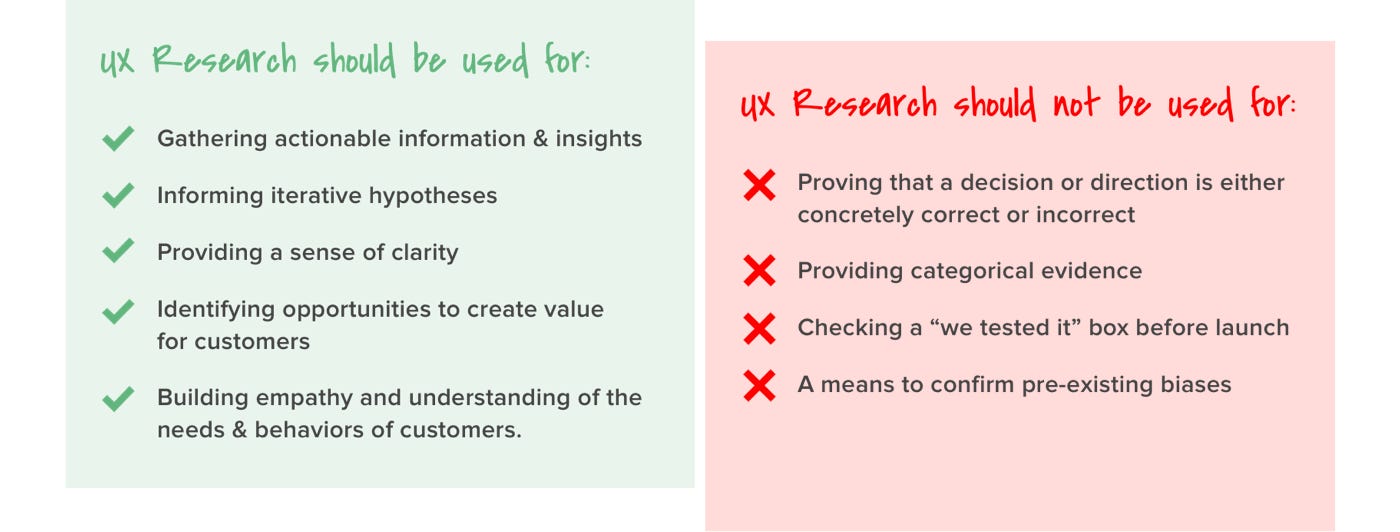
UX研究的見解有幾種不同的形式。 (UX Research insights come in several different forms.)
他們可以: (They can be:)
Behavioral [or] Attitudinal.
行為[或]態度。
Quantitative [or] Qualitative.
定量的[或]定性的。
Generative [or] Evaluative.
生成[或]評估。
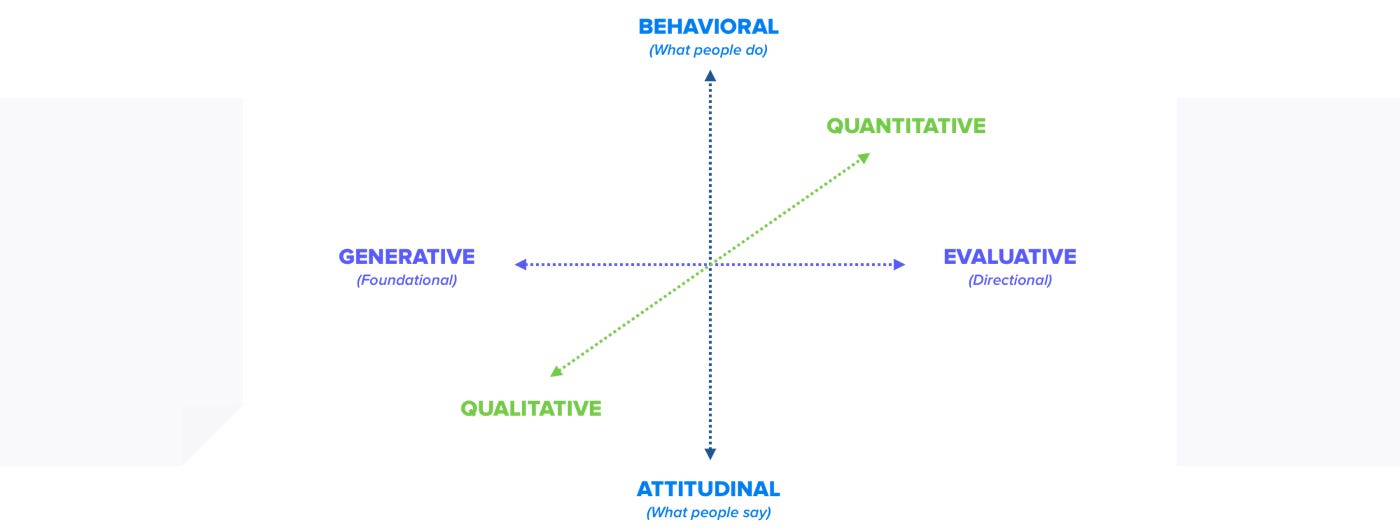
UX研究的見解可以是基礎的[或]定向的。 (UX Research insights can be Foundational [or] Directional.)
Foundational — Generates new ideas; provides us with a direction for what a product could be.
基礎-產生新想法; 為我們提供了產品可能的指導。
Directional — Evaluates an existing idea, product or service; helps us assess if a product or an idea is aligned with user needs.
指導性-評估現有想法,產品或服務; 幫助我們評估產品或想法是否符合用戶需求。

UX研究的見解可以是行為[或]態度。 (UX Research insights can be Behavioral [or] Attitudinal.)
Behavioral — What people do; provides insights into peoples’ behavior.
行為 -人們做什么? 提供有關人們行為的見解。
Attitudinal — How people feel; provides insights into peoples’ attitudes.
態度—人們的感受; 提供有關人們態度的見解。

UX研究的見解可以是定性的或定量的。 (UX Research insights can be Qualitative [or] Quantitative.)
Qualitative — Trends in thought or opinion; provides insights into the context of a need, behavior, preference, or pain point.
定性的-思想或觀點的趨勢; 提供對需求,行為,偏好或痛點背景的見解。
Quantitative — Measurable data; used to identify behavioral patterns and formulate statistically significant insights.
定量的-可測量的數據; 用于識別行為模式并制定具有統計學意義的見解。

為了獲得UX Research的見解,我們可以通過幾種不同的方式與用戶進行交互。 (To acquire UX Research insights, we can interact with users in several different ways.)
Talking — We can talk to users via moderated or unmoderated discussions.
對話-我們可以通過主持或不主持的討論與用戶對話。
Observing — We can observe users via ethnography, contextual inquiry, or usability testing.
觀察-我們可以通過人種志,上下文查詢或可用性測試來觀察用戶。
Measuring — We can measure user behavior using our products via data and analytics metrics.
衡量-我們可以通過數據和分析指標使用我們的產品來衡量用戶行為。

在進行用戶體驗研究時,我們有責任確定與用戶互動以回答我們所遇到的問題的最有效方法。 (When conducting UX Research, it is our responsibility to determine the most effective way to interact with users to answer the questions we have.)
Should we talk to them?Some questions are best answered by talking to users.
我們應該和他們說話嗎? 通過與用戶交談可以最好地回答一些問題。
Should we watch them?Some questions are best answered by observing users.
我們應該看他們嗎? 觀察用戶可以最好地回答一些問題。
Should we measure their behavior?Some questions are best answered by measuring user behavior.
我們應該衡量他們的行為嗎? 通過測量用戶行為,可以最好地回答某些問題。
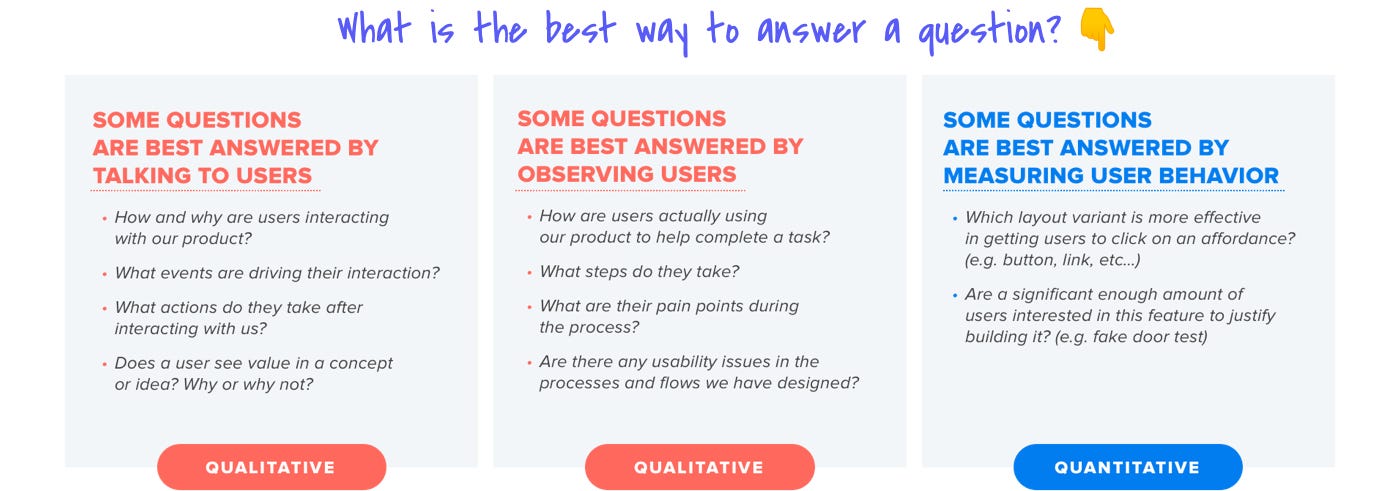
作為UX研究人員,我們面臨的挑戰-人們通常不知道他們想要什么或需要什么。 (Our challenge as UX Researchers — people typically have no idea what they want or need.)
It is our responsibility to objectively interpret what they say and do!
客觀地解釋他們的言行是我們的責任!

對用戶與產品或服務交互的三個方面的理解將使我們能夠分析其行為并解釋其目標,動機和痛點。 (An understanding of three facets of a user’s interaction with a product or service will allow us to analyze their behavior and interpret their goals, motivations, and pain points.)
Context — The internal & external factors that frame a users’ interaction with your product or service.
上下文-構成用戶與您的產品或服務交互的內部和外部因素。
Behavior — How a user engages with your product or service as they attempt to satisfy their need or goal.
行為-用戶在嘗試滿足其需求或目標時如何與您的產品或服務互動。
Outcomes — What a user does, or how they feel, after they are done interacting with your product or service.
結果-用戶與產品或服務進行交互后的行為或感受。


用戶研究的見解可用于整個產品設計和開發過程中,以告知或驗證決策。 (Insights from User Research can be used throughout the product design and development process to inform or validate decisions.)
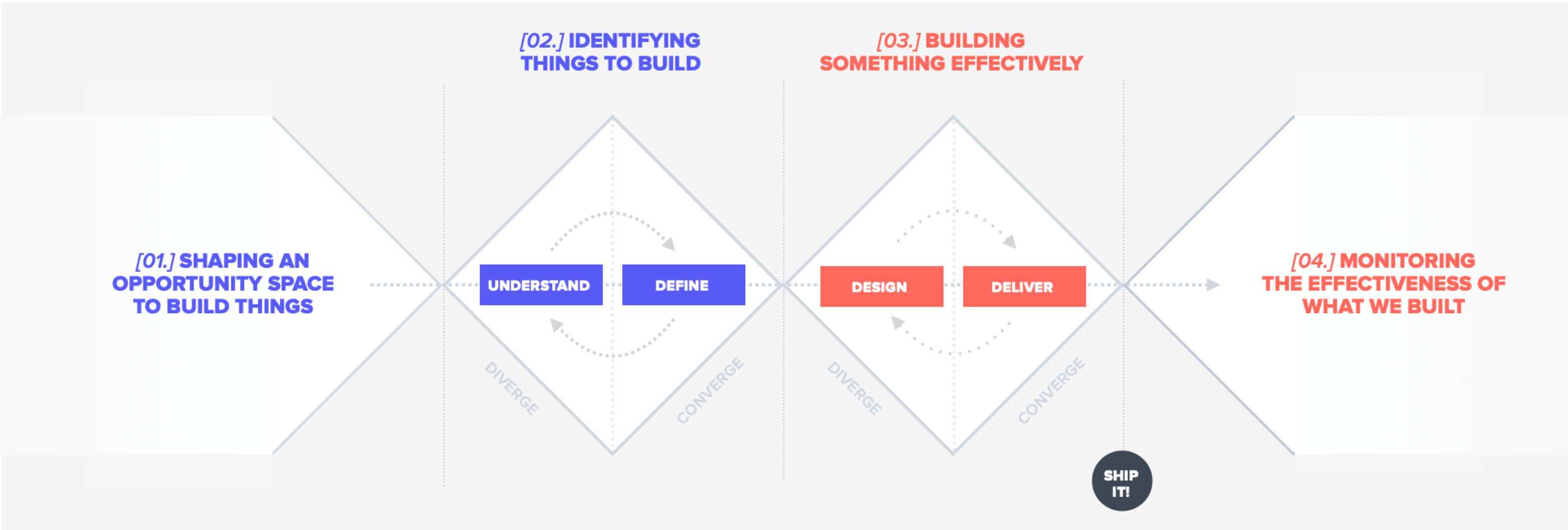
UX研究可以是基礎的[或]定向的 (UX Research can be Foundational [or] Directional)
It can help us identify things to build and build things effectively.
它可以幫助我們識別事物以有效地構建和構建事物。
Foundational Research — Identifying things to build.
基礎研究 -確定要構建的事物。
Research that helps us understand the needs of our customers, and informs what we should build and why.
可以幫助我們了解客戶需求,并告知我們應該建設什么以及為什么的研究。
Directional Research — Building something effectively.
定向研究 -有效地構建事物。
Research that answers specific, tactical questions, and shapes design application for a product or feature.
回答特定的戰術問題并針對產品或功能部件設計應用程序的研究。
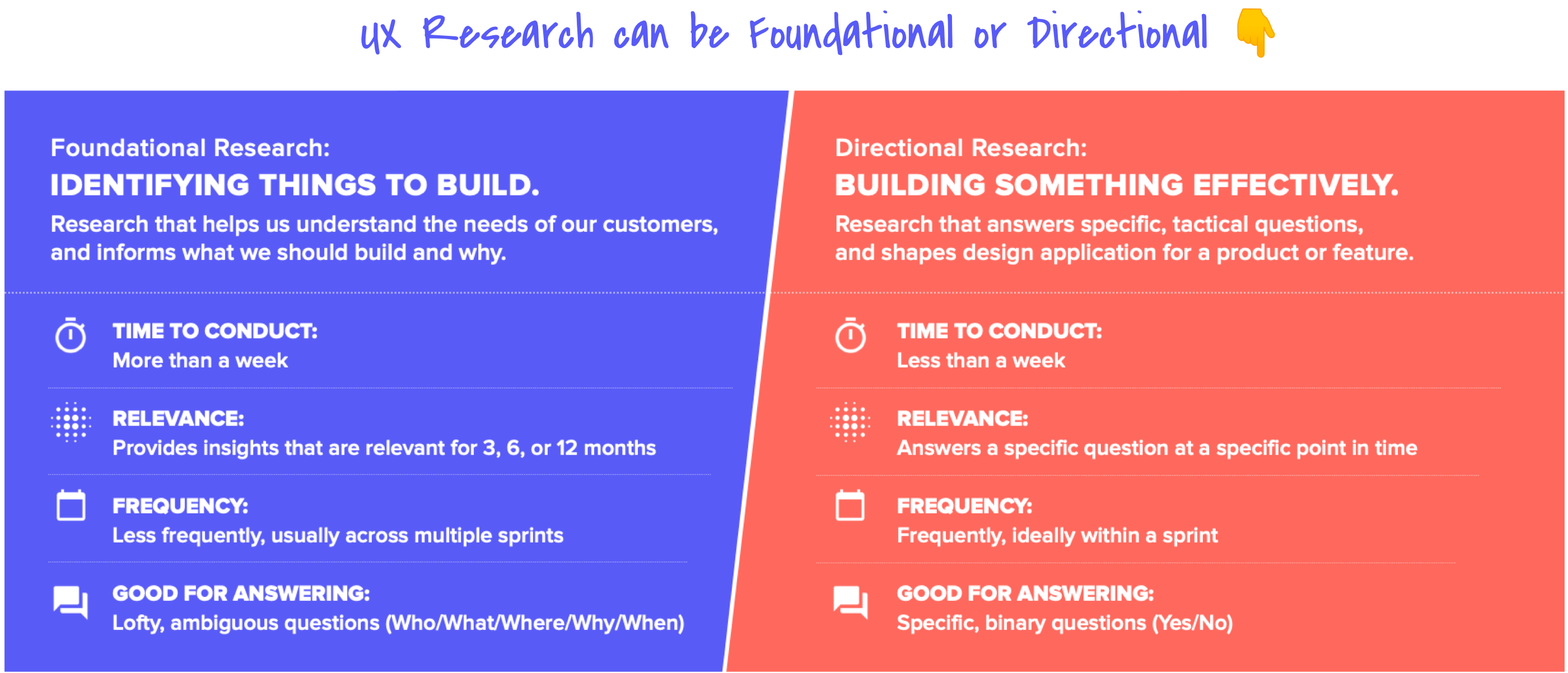
基礎研究通常在產品設計和開發過程的早期進行,而定向研究則在后期進行。 (Foundational Research typically takes place early in the product design and development process, while Directional Research takes place later.)
Foundational Research insights provide the most value early in the product design & development process, when we are still identifying what to build.
當我們仍在確定要構建什么時, 基礎研究洞察力可以在產品設計和開發過程的早期提供最大的價值 。
Directional Research insights provide the most value later in the product design & development process, after we have identified what to build and are determining how to build it in the most effective way.
在我們確定了要構建的內容并確定如何以最有效的方式構建它之后 , 定向研究洞察力在產品設計和開發過程的后期提供最大的價值 。
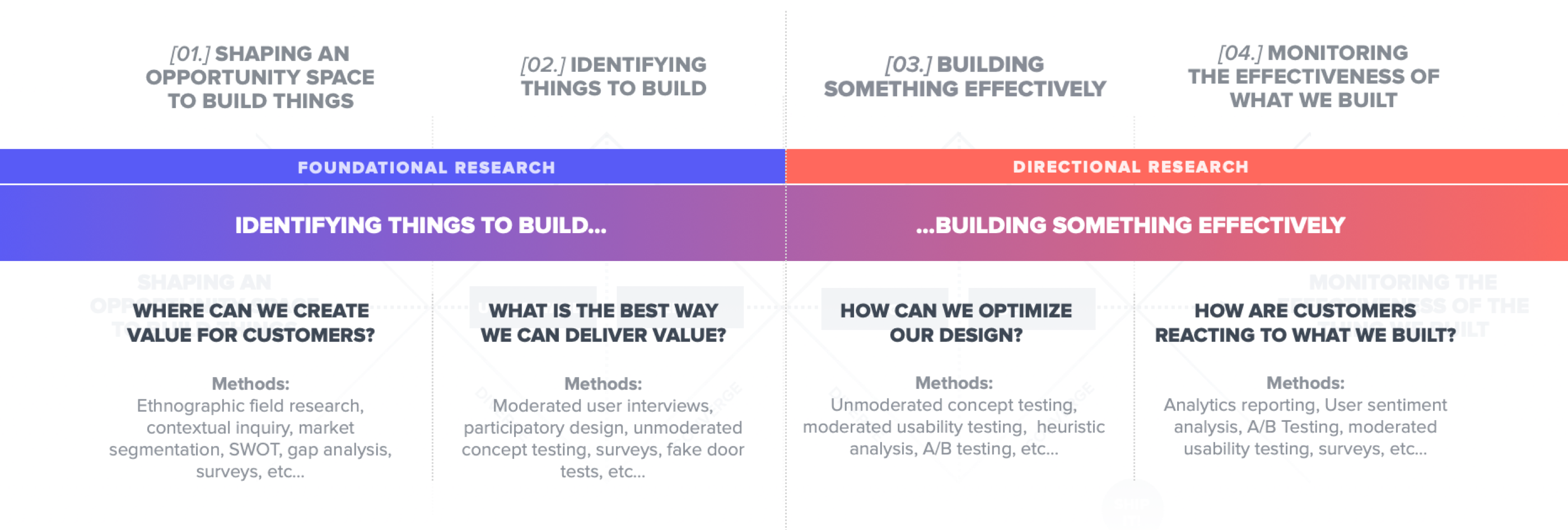
但是,UX Research在何處以及如何適合您的產品設計和開發過程并不需要是二進制的。 (However, where and how UX Research fits into your product design and development process does not need to be binary.)
UX Research的工作時間可以長短不一,并且可以相互依賴-它們可以適合一個沖刺,也可以跨多個沖刺。 (UX Research efforts can vary in length and build upon each other — they can fit within a sprint or span across multiple sprints.)
Foundational — Identifying things to build.Ongoing, iterative discovery that helps us form an understanding of user needs and identify strategic opportunities to create value for them — Who, When, Where, What, How, Why.
基礎-確定要構建的事物。 正在進行的迭代發現可幫助我們了解用戶需求并確定為他們創造價值的戰略機會-誰,何時,何地,什么,如何,為什么。
Directional — Building something effectively.Small research efforts that answer a specific question, validate a hypothesis, or measure the effectiveness of a decision.
定向-有效構建內容。 回答特定問題,驗證假設或衡量決策有效性的小型研究工作。

使用研究來確定要構建的事物。 (Using research to identify things to build.)
Foundational (understanding): Iterative customer discovery that helps us understand our users.
基礎(理解):迭代的客戶發現,可幫助我們了解用戶。
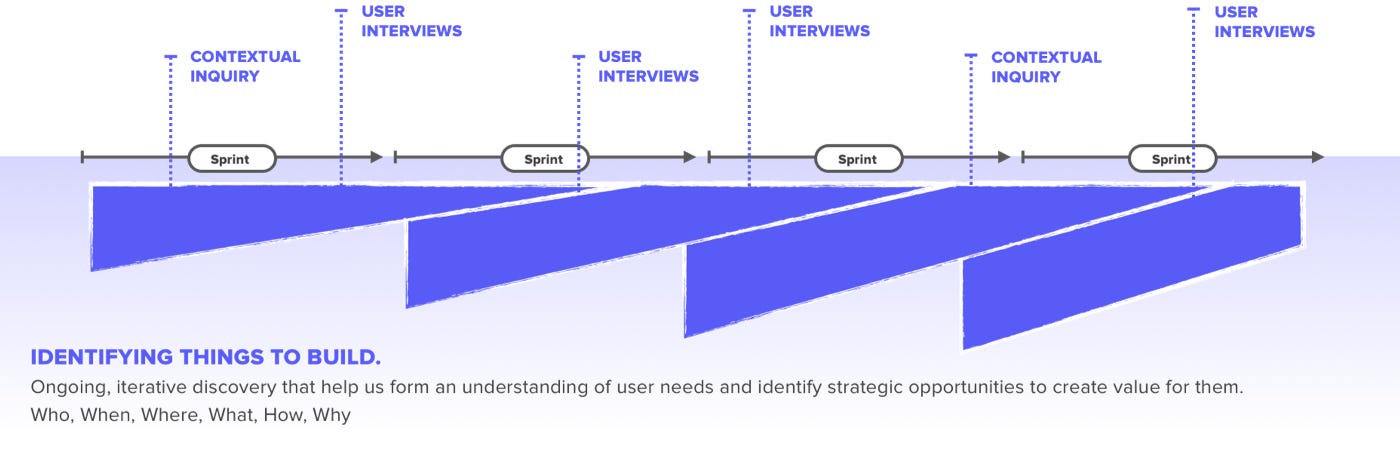
利用研究有效地構建事物。 (Using research to build something effectively.)
Directional (feedback): Quick research efforts that help answer tactical questions.
定向(反饋):快速研究工作,有助于回答戰術問題。


進行研究時,可以使用多種UX研究方法來收集所需的見解。 (When conducting research, there are a variety of UX Research methodologies we can utilize to collect the insights we need.)
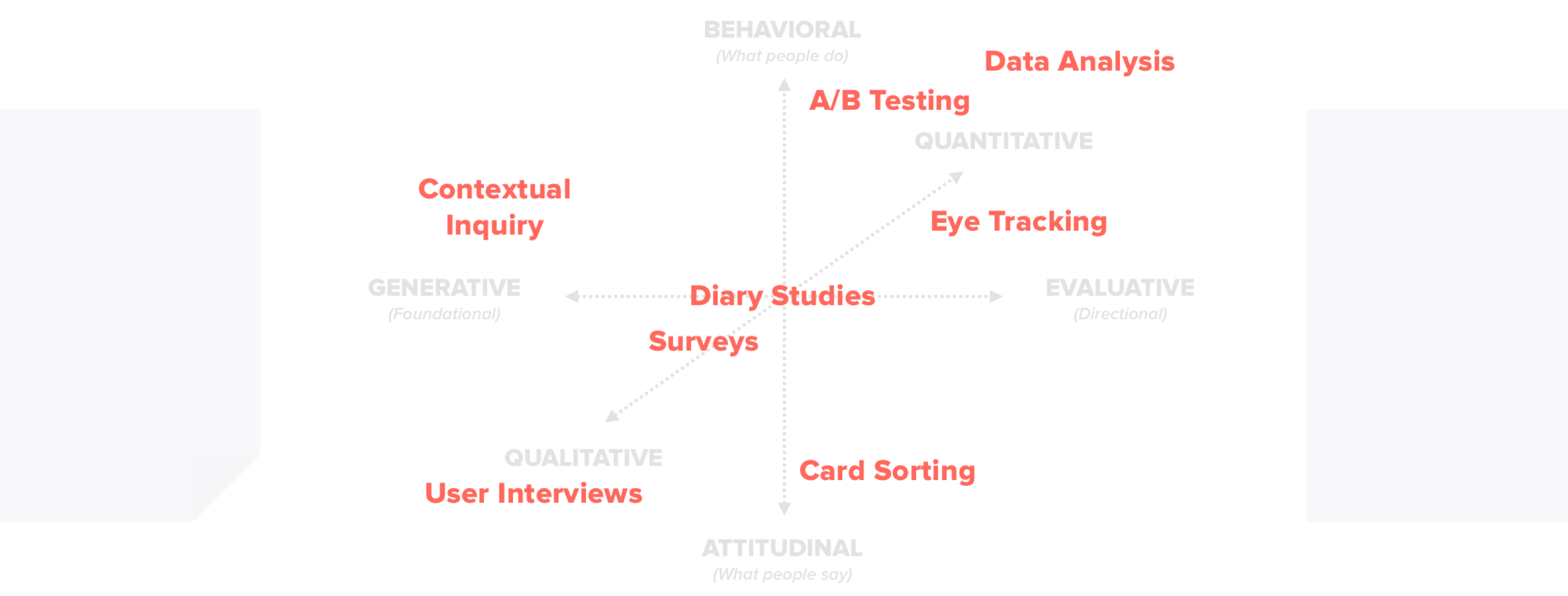
UX研究方法各不相同-每種方法都唯一適合提供特定類型的見解。 (UX Research methodologies vary — each uniquely suited to provide a specific type of insights.)
As User Researchers it is our responsibility to identify the best approach and methodology to answer our question, then assess if this approach is the most efficient (and feasible) way to answer it.
作為用戶研究人員,我們有責任確定最佳的方法和方法來回答我們的問題,然后評估這種方法是否是回答問題的最有效(最可行)的方法。
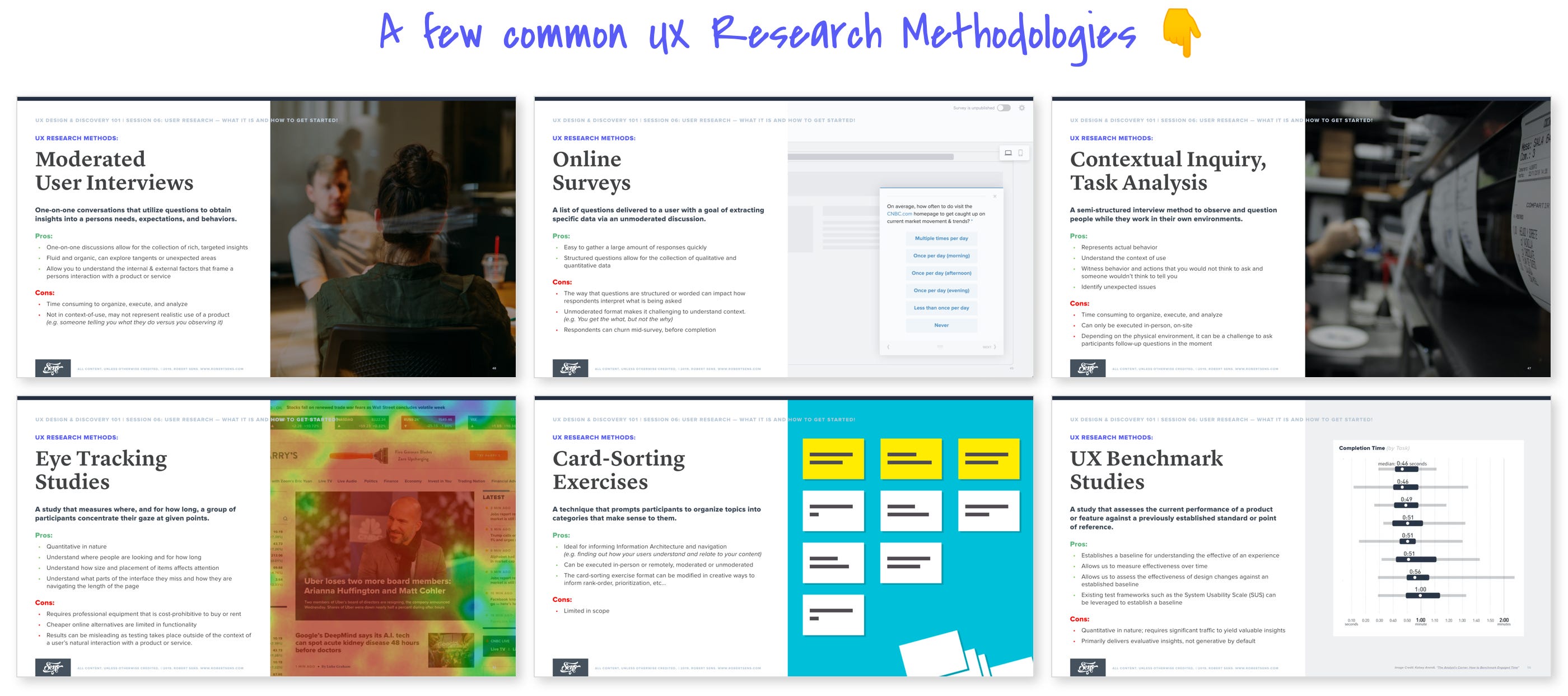

編排UX研究需要人員,流程和技術的協調 。 (Orchestrating UX Research requires the coordination of People, Processes, and Technology.)
People — Who is doing what? When are they doing it?
人-誰在做什么? 他們什么時候做的?
Process — What do we need to do? When does it need to get done?
流程-我們需要做什么? 什么時候需要完成?
Technology — What tools are we using? How are we using them?
技術-我們使用什么工具? 我們如何使用它們?
可以將UX Research的規劃,執行和綜合分為一個連續的五步過程。 (Planning, conducting, and synthesizing UX Research can be broken down into a sequential, five-step process.)

步驟01:評估UX Research的機會。 (Step 01: Assess the opportunity for UX Research.)
Identify your questions, then evaluate if and how they should be answered via user research.
確定您的問題,然后評估是否以及如何通過用戶研究回答這些問題。
任務: (Tasks:)
- Identify the question or questions you want to answer 確定您要回答的問題
- Evaluate if there are existing insights that can be leveraged 評估是否可以利用現有的見解
- Assess the effort/value of answering your question via UX research 通過UX研究評估回答問題的努力/價值

步驟02:規劃研究。 (Step 02: Plan your research.)
Determine your research goal, plan research activities, and develop any required supporting materials (discussion guides, prototypes, etc…).
確定您的研究目標,計劃研究活動,并開發任何必要的輔助材料(討論指南,原型等) 。
任務: (Tasks:)
- Draft a research brief with goals and outcomes 起草具有目標和成果的研究摘要
- Finalize the methodologies you will use 最終確定您將使用的方法
- Create a test plan and discussion guide 制定測試計劃和討論指南
- Develop prototypes and supporting materials 開發原型和輔助材料
- Plan for and coordinate all logistics 規劃和協調所有物流
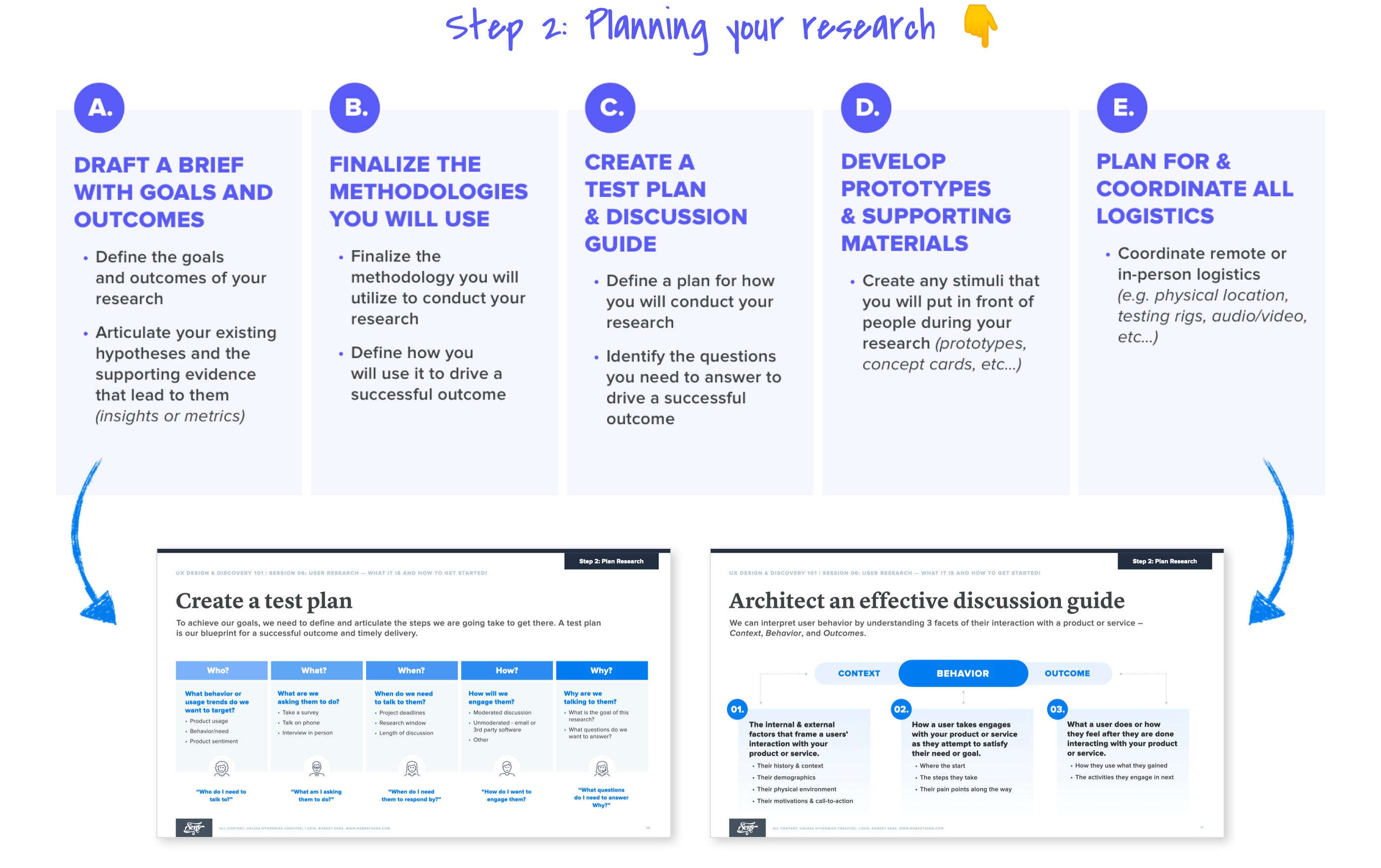
步驟03:請參與者進行研究。 (Step 03: Solicit participants for your research.)
Identify and solicit the right participants for your research activities.
為您的研究活動確定并吸引合適的參與者。
任務: (Tasks:)
- Define targeting criteria 定義定位條件
- Source potential participants 吸引潛在參與者
- Draft outreach communication 草擬外展交流
- Engage with and/or contact users 與和/或聯系用戶
- Schedule and confirm participants 安排并確認參與者
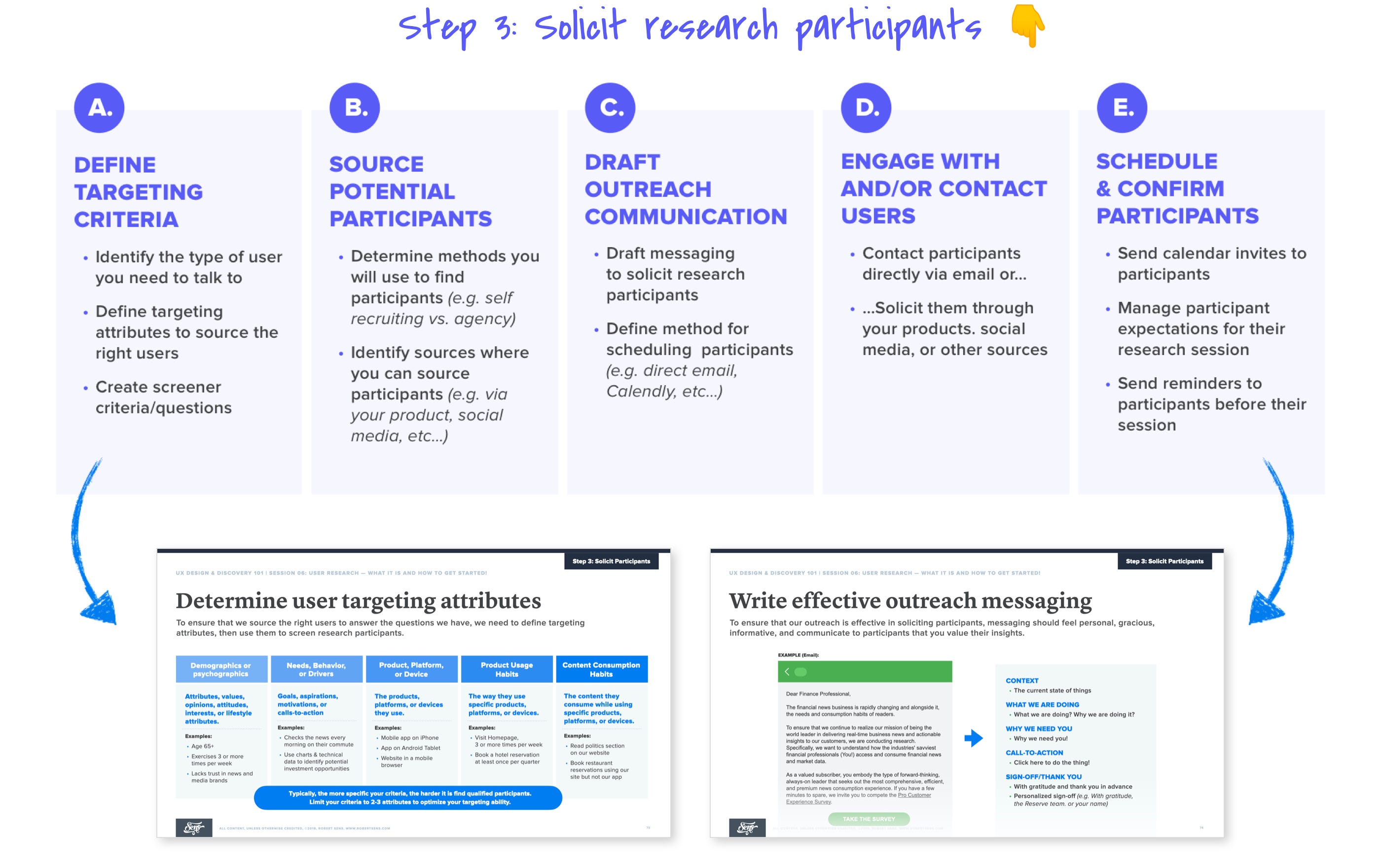
步驟04:進行研究。 (Step 04: Conduct your research.)
Engage participants and conduct the research activities you planned.
吸引參與者并進行您計劃的研究活動。
任務: (Tasks:)
Assemble your research team and assign roles (if applicable)
組建研究團隊并分配角色(如果適用)
- Finalize, deploy, and facilitate activities 完成,部署和促進活動
- Document research activities in real-time 實時記錄研究活動
- Conduct post-session synthesis with your team 與您的團隊進行會后綜合
- Thank participants and fulfill any incentives 感謝參與者并兌現獎勵措施
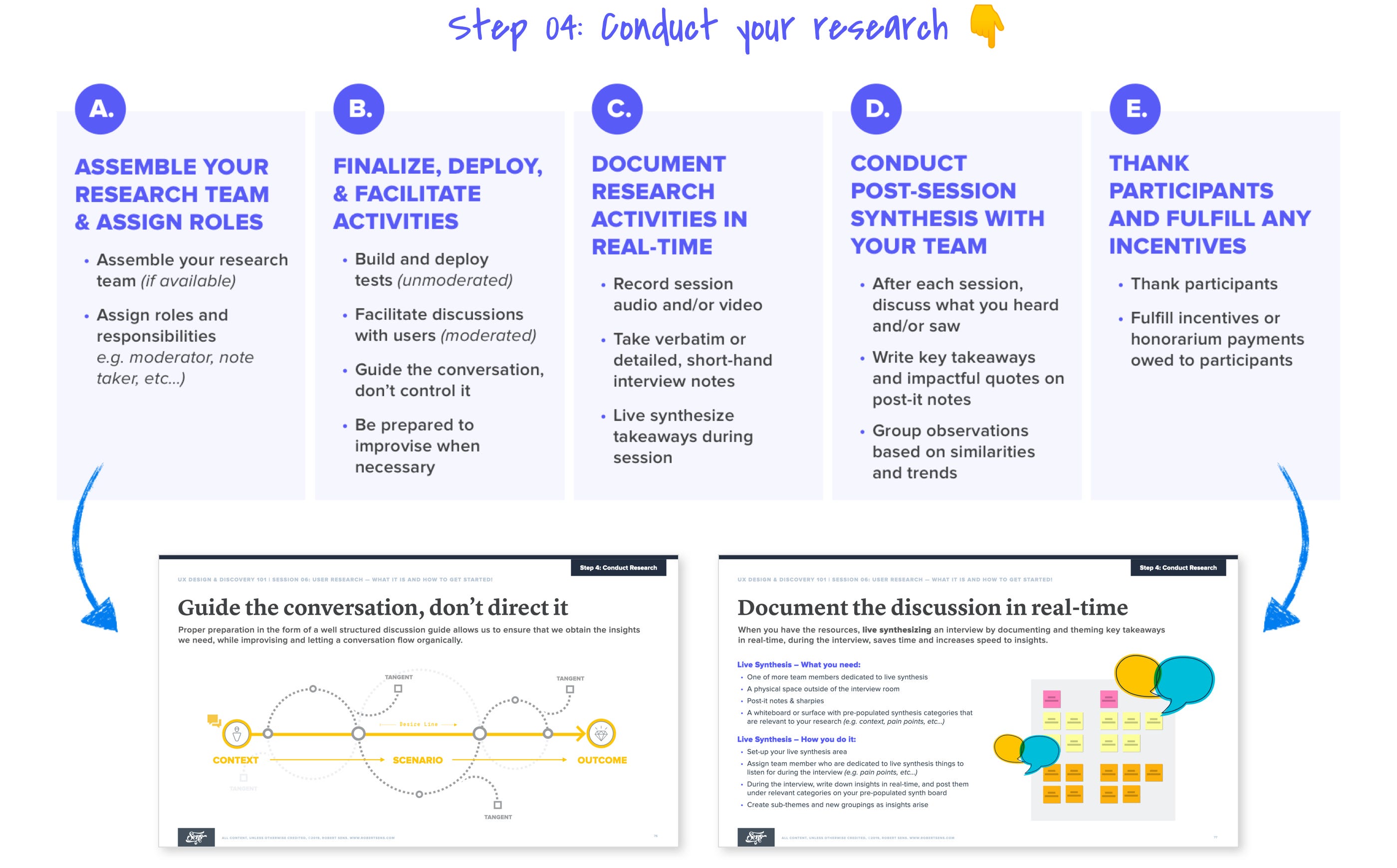
步驟05: 了解您所聽到的內容。 (Step 05: Make sense of what you heard.)
Synthesize what you heard, generate insights, then share what you learned with your peers.
綜合您聽到的內容,產生見解,然后與同行分享您學到的知識。
任務: (Tasks:)
- Organize raw data from activities 組織活動中的原始數據
- Analyze raw data and theme findings 分析原始數據和主題發現
- Identify takeaways, hypotheses, and additional questions 確定要點,假設和其他問題
- Develop supporting artifacts 開發輔助工件
- Share-out findings with your peers 與同行分享調查結果
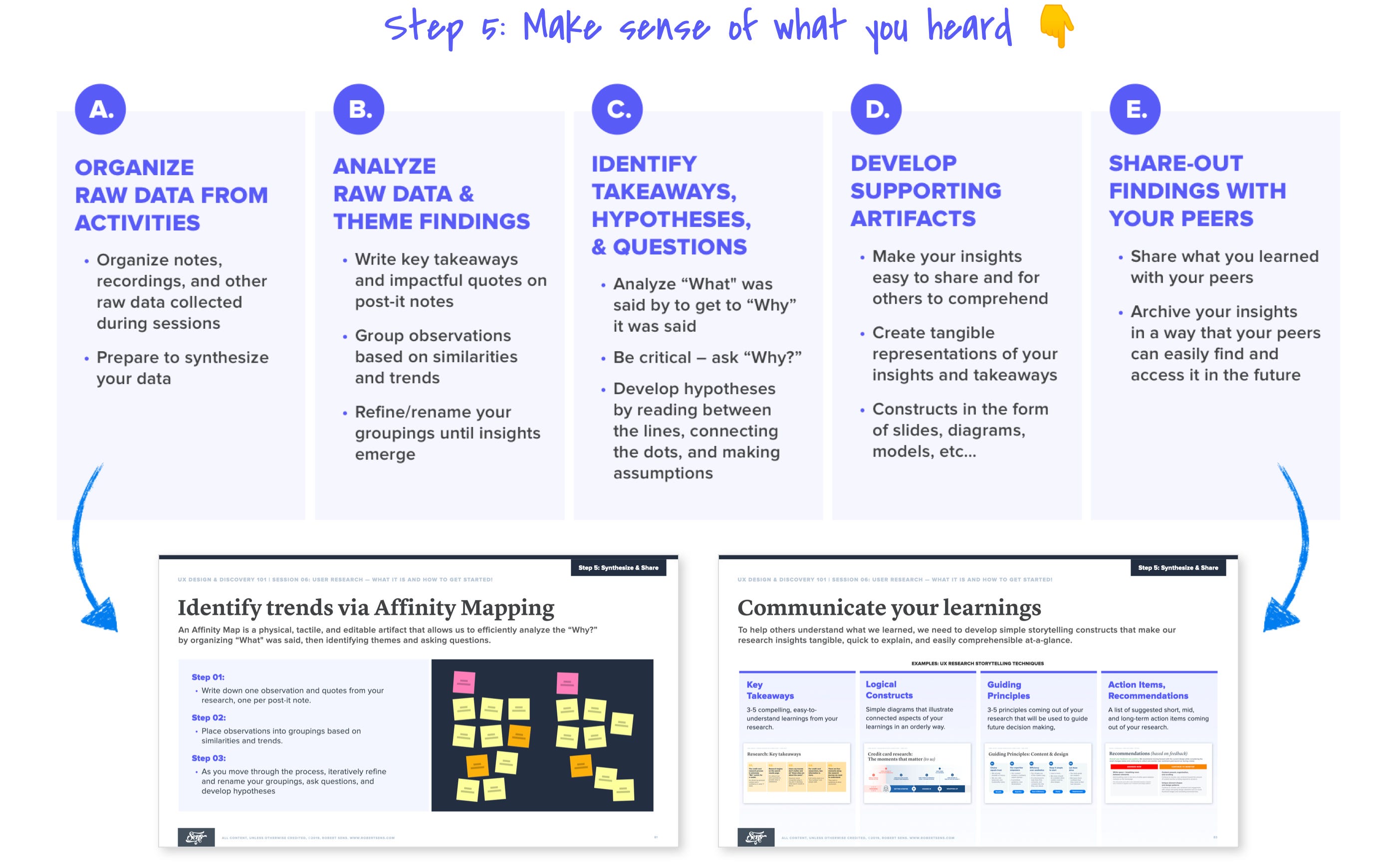

本次會議如何安排和促進? (How is this session structured & facilitated?)
This session is a mix of theory and short, hands-on activities that enable participants to apply concepts in real-time.
本次會議結合了理論和簡短的動手操作,使參與者能夠實時應用概念。
Participants are walked through the basic of UX Research including what it is, the value it provides, how it fits within the product design & development process, and the pros/cons of popular research methodologies. They are then introduced to a five-step framework for planning and conducting their own research. Throughout the session, several short, hands-on exercises are used to reinforce the content.
參與者將了解UX研究的基礎知識,包括它的含義,它提供的價值,它如何適合產品設計和開發過程以及流行研究方法的利弊。 然后將它們引入一個五步框架來計劃和進行自己的研究。 在整個會話中,將使用一些簡短的動手練習來增強內容。
The facilitator deck & exercise structure can be reviewed below. 👇👇🏼👇🏾
主持人平臺和練習結構可以在下面進行審查。 👇👇🏼👇🏾

您如何在本節中執行練習? (How can you execute the exercises in this session?)
There are three short, participatory exercises intertwined within the content of this session — each lesson builds upon the previous one.
在本次會議的內容中,有三個簡短的參與性練習相互交織-每個課程都在前一個課程的基礎上進行。
練習01-說話,觀察還是測量? (Exercise 01 — Talk, Observe, or Measure?)
The goal of this exercise is to help participants understand how to analyze and determine what is the most effective way to understand user behavior — talking to them, observing them, or measuring their behavior over time.
該練習的目的是幫助參與者了解如何分析和確定了解用戶行為的最有效方法,即與他們交談,觀察他們或隨時間測量他們的行為。
In this exercise, participants are asked to think about a challenging design decision they are facing (or have faced in the past) where insights into user behavior would have helped them more effectively or efficiently make a decision. Using their scenario, participants are prompted to analyze, then discuss, what method of interacting with users would be most effective — Talking, Observing, or Measuring?
在本練習中,要求參與者思考他們面臨的(或過去曾經面臨的)具有挑戰性的設計決策,對用戶行為的洞察力將有助于他們更有效地做出決策。 使用他們的場景,提示參與者分析然后討論與用戶交互的哪種方法最有效-交談,觀察或度量?

練習1:格式 (Exercise 1: Format)
After providing participants with an introduction to user research and the three different ways that we can interact users to gain insights into their behavior, ask participants to identify, then discuss, how they might utilize the these methods.
在向參與者介紹了用戶研究以及我們與用戶進行交互以了解其行為的三種不同方式之后,請參與者確定然后討論他們如何利用這些方法。
First, ask participants to identify a challenging design decision they are facing (or have faced in the past), where insights into user behavior could have helped them more effectively or efficiently make a decision.
首先,請參與者確定他們面臨的(或過去曾經面臨的)具有挑戰性的設計決策,對用戶行為的洞察力可以幫助他們更有效地做出決策。
Thinking about this challenge, prompt participants to identify which method would be most effective — Talking, Observing, or Measuring?
考慮到這一挑戰,請參與者確定哪種方法最有效- 交談 , 觀察或衡量 ?
- Give participants 5 minutes to complete the tasks outlined above. Provide post-notes and a Sharpie and encourage them to write down their thoughts so that they can be easily shared with the group. 給參與者5分鐘的時間來完成上述任務。 提供便簽和Sharpie,并鼓勵他們寫下自己的想法,以便與小組輕松共享。

練習1:總結 (Exercise 1: Wrapping-up)
After the exercise, prompt participants to spend a few minutes sharing and discussing their thinking, then provide an example of your own.
練習后,提示參與者花幾分鐘時間分享和討論他們的想法,然后提供一個自己的例子。
- Ask 1–2 participants to share and discuss their thinking. If no one steps up, ask directly. 讓1-2位參與者分享和討論他們的想法。 如果沒有人加強,請直接詢問。
- As participants share, prompt a conversation by asking others in the room if they agree with the presenters assessment of which method of interacting with users would be most effective to get the insights they need. 當參與者共享時,通過詢問房間中的其他人是否同意演示者對哪種與用戶交互方法最能獲得他們所需的見解的評估,來促進對話。
Afterward, provide an example of your own that clearly connects the learnings from the session with a real-world application (examples above).
然后,提供您自己的示例,該示例將會話中的學習內容與實際應用程序清楚地聯系起來(上述示例) 。

練習02 —基礎還是定向? (Exercise 02 — Foundational or Directional?)
The goal of this exercise is to help participants understand the differences between Foundational and Directional research.
本練習的目的是幫助參與者了解基礎研究和定向研究之間的差異。
This exercise builds upon the previous exercise. Participants are asked to think about the same challenging decision they used in the previous exercise — a decision where insights into user behavior could have helped them more effectively or efficiently make a decision.
本練習以之前的練習為基礎。 要求參與者考慮他們在上一個練習中使用的相同的具有挑戰性的決定,即對用戶行為的洞察力可以幫助他們更有效地做出決定的決定。
Using their scenario, participants are prompted to think deeper about the question they have (or had) about user behavior, then analyze whether their question is Foundational or Directional.
使用他們的場景,會提示參與者對他們已經(或曾經)關于用戶行為的問題進行更深入的思考,然后分析他們的問題是基礎問題還是定向問題 。

練習2:格式 (Exercise 2: Format)
After walking participants through an overview of Foundational and Directional UX Research and discussing where it fits within the product design & development process, prompt participants to think deeper about the question(s) they have, then identify and discuss whether the insights derived from answering them would be Foundational or Directional.
在向參與者介紹了基礎和定向 UX研究的概述并討論了它在產品設計和開發過程中的適用位置之后,提示參與者對他們所遇到的問題進行更深入的思考,然后確定并討論是否從回答這些問題中得出了真知灼見。將是基礎的或定向的 。
- First, ask participants to think about the challenging decision they considered in the first exercise — an instance where insights into user behavior could have helped them more effectively or efficiently make a decision. 首先,請參與者考慮他們在第一次練習中所考慮的具有挑戰性的決策,在這種情況下,對用戶行為的洞察力可以幫助他們更有效地做出決策。
- Next, prompt participants to think deeper — Ask them what questions they have about user behavior that, if answered, would help them more effectively or efficiently make a decision. 接下來,提示參與者進行更深入的思考-問他們對用戶行為有什么問題,如果回答了這些問題,將有助于他們更有效地做出決定。
- Provide post-it notes and a Sharpie, then give participants a few minutes to think and write down their questions. 提供便利貼和Sharpie,然后讓參與者有幾分鐘的時間思考并寫下他們的問題。
After they have identified a few questions, ask participants to assess whether the insights derived from answering these questions would be Foundational or Directional, and why.
在確定了幾個問題之后,請參與者評估從回答這些問題中得出的見解是基礎的還是定向的 ,以及原因。
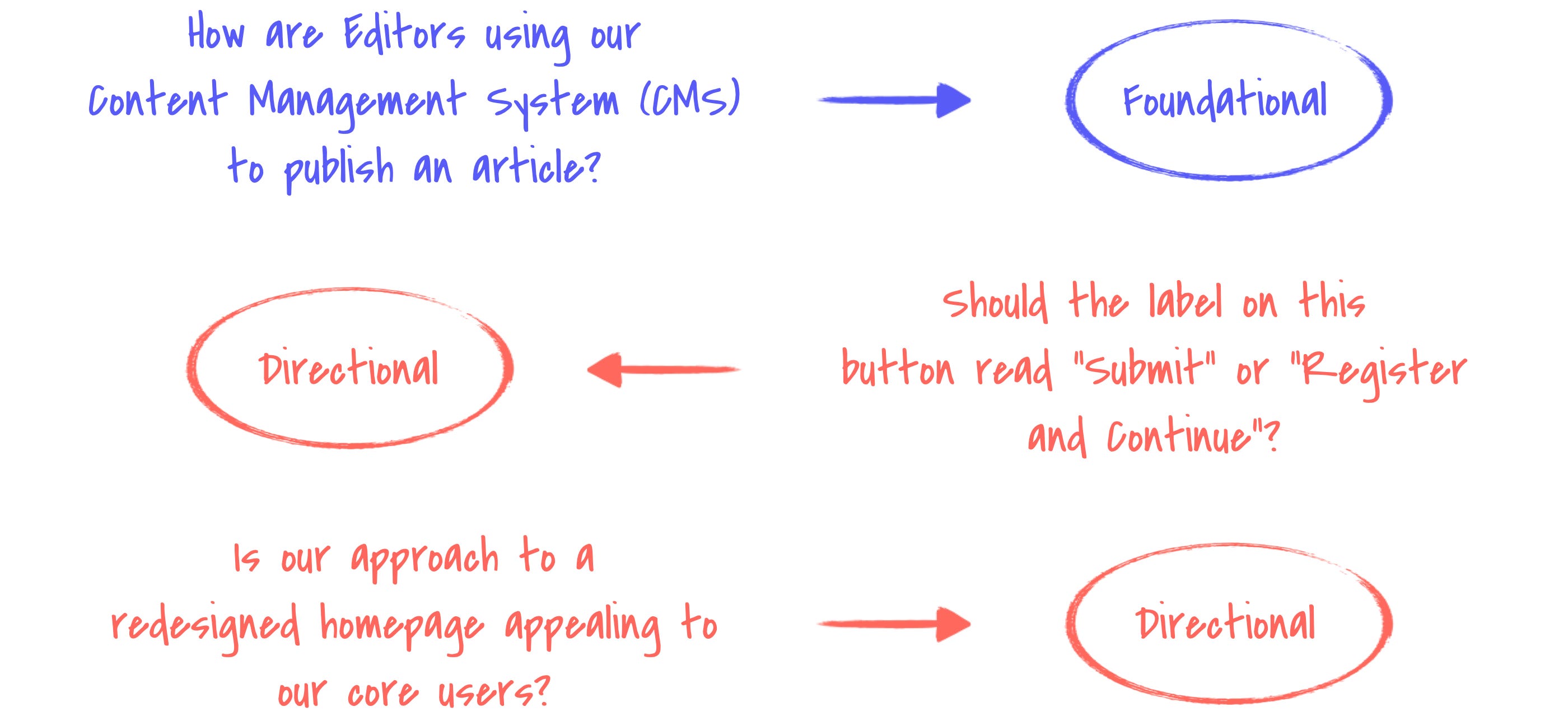
練習2:總結 (Exercise 2: Wrapping-up)
After the exercise, prompt participants to spend a few minutes sharing and discussing their thinking, then provide an example of your own.
練習后,提示參與者花幾分鐘時間分享和討論他們的想法,然后提供一個自己的例子。
- Ask 1–2 participants to share and discuss their thinking. If no one steps up, ask directly. 讓1-2位參與者分享和討論他們的想法。 如果沒有人加強,請直接詢問。
As participants share, prompt a conversation by asking others in the room if they agree with the presenters assessment of whether the insights derived from a question are Foundational or Directional.
在與會人員共享時,通過詢問會議室中的其他人是否同意演示者對從問題中得出的見解是基礎還是定向的評估,來促進對話。
Afterward, provide an example of your own that clearly connects the learnings from the session with a real-world application (examples above).
然后,提供您自己的示例,該示例將會話中的學習內容與實際應用程序清楚地聯系起來(上述示例) 。

練習03 —哪種研究方法? (Exercise 03 — Which research methodology?)
The goal of this exercise is help participants identify the UX Research methodologies they could use to gather Foundational or Directional UX Research insights and answer a question they have.
本練習的目的是幫助參與者識別UX Research方法論,以用于收集基礎或定向 UX Research見解,并回答他們所遇到的問題。

This exercise builds upon the previous two exercises. Participants are asked to think about the challenging decision they previously considered — a decision where insights into user behavior would help them more effectively or efficiently make a decision.
本練習以前兩個練習為基礎。 要求參與者考慮他們以前考慮過的具有挑戰性的決定,即對用戶行為的洞察力將有助于他們更有效地做出決定的決定。
Using this scenario, participants are prompted to think about their insights from the previous two exercises, then use them to determine which UX Research methodology (or methodologies) would help them gather the insights they need.
在這種情況下,會提示參與者考慮前兩個練習的見解,然后使用它們來確定哪種UX Research方法論(或多種方法論)將幫助他們收集所需的見解。
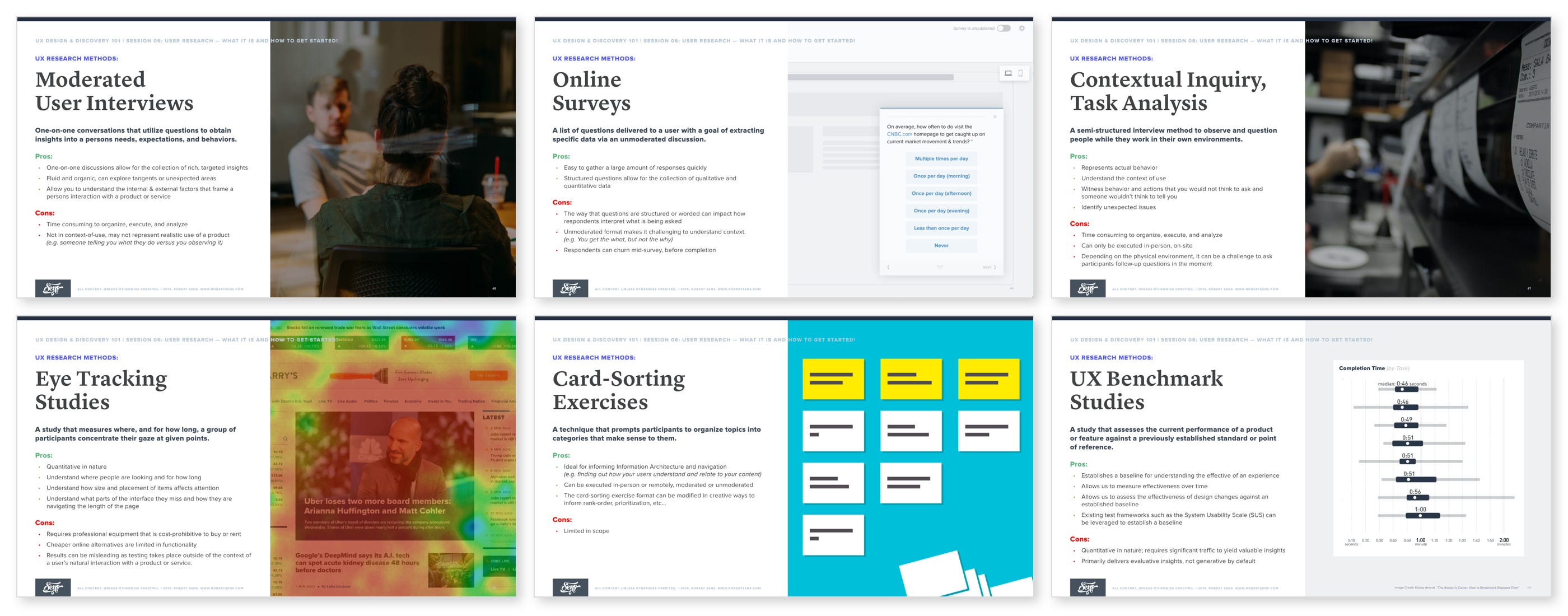
練習3:格式 (Exercise 3: Format)
First, walk participants through an overview of common research methods — including what they are, their pros and cons, their value in providing Foundational or Directional UX Research insights, and where they fit within the product design & development process.
首先,向參與者介紹常見的研究方法,包括它們的用途,利弊,在提供基礎或定向 UX研究見解方面的價值以及它們在產品設計和開發過程中的適用范圍。
Afterward, prompt participants to think deeper about the question they have, then based on what they have learned, identify the UX Research methods that they believe would be most effective.
然后,提示參與者對他們所遇到的問題進行更深入的思考,然后根據所學知識,確定他們認為最有效的UX研究方法。
- First, ask participants to think about the question they have about user behavior — a question, that if answered, would help them more effectively or efficiently make a decision. 首先,請參與者考慮他們對用戶行為的問題-一個問題,如果得到回答,將有助于他們更有效地做出決定。
Next, prompt participants to think about which UX Research methodology (or methodologies) would be the most effective and efficient to obtain the insights they need to answer their question.
接下來,提示參與者考慮哪種UX研究方法論(一種或多種方法論)將是最有效,最有效的方法,以獲取他們所需的見解來回答他們的問題。
- Provide post-notes and a Sharpie and give participants a few minutes to think and write down their thoughts and ideas. 提供便簽和Sharpie,并給參與者幾分鐘的時間來思考和寫下他們的想法。

練習3:總結 (Exercise 3: Wrapping-up)
After the exercise, prompt participants to spend a few minutes sharing and discussing their thinking, then provide an example of your own.
練習后,提示參與者花幾分鐘時間分享和討論他們的想法,然后提供一個自己的例子。
- Ask 1–2 participants to share and discuss their thinking. If no one steps up, ask directly. 讓1-2位參與者分享和討論他們的想法。 如果沒有人加強,請直接詢問。
- As participants share, prompt a conversation around the presenters decision and rationale for using a particular UX Research method by soliciting feedback from others in the room. 當參與者共享時,通過征詢會議室中其他人的反饋,促使對話者圍繞演示者的決策和基本原理進行討論,以使用特定的UX研究方法。
Afterward, provide an example of your own that clearly connects the learnings from the session with a real-world application (examples above).
然后,提供您自己的示例,該示例將會話中的學習內容與實際應用程序清楚地聯系起來(上述示例) 。

本系列的下一期是什么? (What’s the next session in this series?)
The next session in this series introduces techniques for establishing context around UX Research and choosing the right methodologies.
本系列的下一節將介紹圍繞UX Research建立上下文并選擇正確方法的技術。
Session 07: Value vs. effort — Choosing a user research methodology 👇🏼
會議07:價值與努力-選擇用戶研究方法methodology
The step-by-step framework and hands-on exercises in this session internalize the value of Context by challenging each participant to answer a series of up-front questions that establish the Who, What, Where, When, and Why around a question they (or their team) want to answer via UX Research.
本節課中的分步框架和動手練習將內部化 通過挑戰每個參與者回答一系列預先問題來確定上下文的價值,這些問題確定了他們(或他們的團隊)想要通過UX Research回答的問題的“ 誰,什么,什么地方,什么時候,為什么” 。
These techniques enable teams conducting UX Research to set themselves up for success and enhance their potential to produce actionable insights from UX Research activities.
這些技術使進行UX Research的團隊能夠為成功做好準備,并增強他們從UX Research活動中產生可行的見解的潛力。

下一步是什么? (What’s next?)
Thank you for reading! Over the next few months, I will continue to add detailed session plans for each of the sessions outlined in this curriculum. In the meantime, any and all feedback is appreciated. 💭
感謝您的閱讀! 在接下來的幾個月中,我將繼續為本課程中概述的每個課程添加詳細的課程計劃。 同時,感謝所有反饋。 💭
翻譯自: https://blog.prototypr.io/ux-design-101-user-research-everything-you-need-to-know-to-get-started-41f3f200a77
hp-ux鎖定用戶密碼
本文來自互聯網用戶投稿,該文觀點僅代表作者本人,不代表本站立場。本站僅提供信息存儲空間服務,不擁有所有權,不承擔相關法律責任。 如若轉載,請注明出處:http://www.pswp.cn/news/274352.shtml 繁體地址,請注明出處:http://hk.pswp.cn/news/274352.shtml 英文地址,請注明出處:http://en.pswp.cn/news/274352.shtml
如若內容造成侵權/違法違規/事實不符,請聯系多彩編程網進行投訴反饋email:809451989@qq.com,一經查實,立即刪除!











無線網卡)

 ---- 翻譯的很好!)


)

